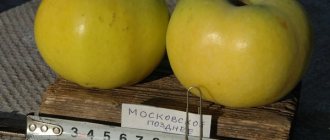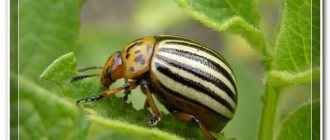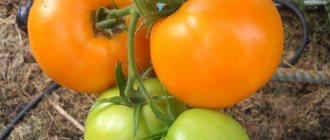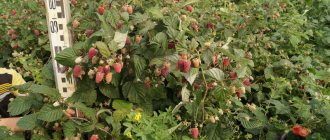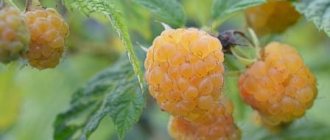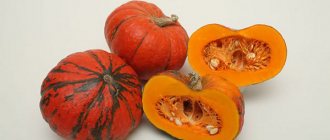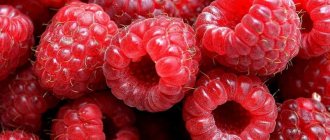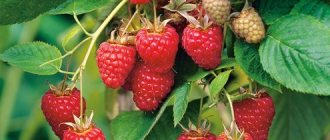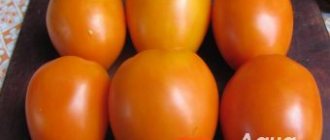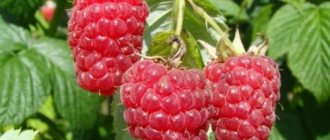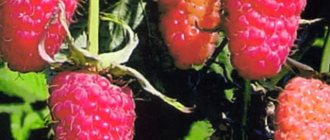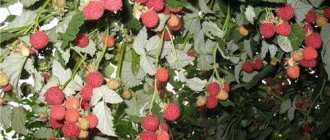Remontant raspberries called Golden Domes are a wonderful variety selected by domestic scientists from the All-Russian Breeding and Technological Institute of Horticulture and Nursery Growing. It was developed at the Kokinsky stronghold of VSTISP located in the Bryansk region by a team of authors consisting of V.L. Kulagina, S.N. Evdokimenko, under the guidance of the most famous specialist in this culture, academician of the Russian Academy of Agricultural Sciences, Honored Scientist of the Russian Federation I.V. Kazakova.
Ivan Vasilyevich devoted his entire life to raspberries, and his remontant varieties became a world-class achievement, becoming widespread in a variety of countries and regions. He managed to ensure that new forms had a short growing season with a modest amount of active temperatures, managing to produce a significant part of their potential harvest in the middle zone of our country before the onset of frost. In addition, the main criteria for selecting hybrid offspring were necessarily the high gastronomic and aesthetic qualities of the fruit, increased resistance to pests and diseases, general unpretentiousness in cultivation and, of course, decent yield.
Our heroine fully possesses all these qualities. It is distinguished by fairly large berries, good productivity, high economic characteristics, dessert taste and versatility in the use of the crop. All this made this raspberry popular among amateur gardeners, and also opened up prospects for its industrial cultivation. It is not for nothing that the variety passed strict state variety testing, and according to its results, in 2005, it was officially included in the State Register of Breeding Achievements of the Russian Federation and recommended for cultivation in the regions of the Central Non-Black Earth Region.
Description
The Golden Domes raspberry variety was created by Russian breeders. Today it is on the State Register lists. It is recommended to grow a remontant plant in the Central region of Russia, but self-fertile raspberries have long crossed the proposed boundaries.
Bushes
The variety Golden Domes is remontant, with medium branching, spreading. The height of the bush varies between 1.3-1.5 m. The growth of erect shoots is moderate, which has a positive effect on care. There are few offspring of the first year on the raspberry variety; they are easy to distinguish by their light green color and slight pubescence and waxy coating. In addition, they are much thinner than two-year-old shoots. On two-year-olds, the bark is soft brown.
Important! The thorns of this variety of remontant raspberry are present on any shoot along the entire length, but they are thin and, according to reviews from gardeners, do not cause any inconvenience.
Sheet plastic is medium in size, rich green in color. Slight pubescence and wrinkling are present. Raspberry leaves of the Golden Domes variety are slightly curled.
Fruit
The variety's berries are hemispherical, weighing up to 3.8 grams. They are located on a short stalk and are easily separated. The particles will not separate when picked and processed; the raspberry fruits retain their integrity. The berries are slightly pubescent; at an early stage of ripening they are yellow; when slightly overripe, they take on the color of an apricot.
Important! Yellow raspberry fruits do not cause allergic reactions, so they can be safely included in the diet of children and pregnant women.
The fruits are tender, juicy with subtle notes, somewhat different from the usual raspberry taste: the berries of the Golden Domes variety are sweet and sour. If we consider the composition, then raspberries contain 13.8% dry matter, sugar 6.4%, ascorbic acid C 17.8 mg/%.
Productivity
According to the description of the variety, reviews from gardeners and photos sent, fruiting of remontant raspberries Zolotye Domes is abundant. You can see this for yourself.
As a rule, with proper care and compliance with agricultural practices, more than two kilograms of amber berries are harvested from a remontant raspberry bush. Farmers set the yield level at 100 centners of raspberry varieties per hectare.
Attention! The Golden Dome raspberries bear fruit in two waves: the first ripening of yellow berries occurs in June-July, the second in August-September.
Characteristics of the variety
To obtain information about the characteristics of a variety, descriptions and photos are not always enough. It is important for gardeners to know the positive and negative aspects of Golden Dome raspberries in order to decide to grow them.
Advantages
- Terms of ripening. The raspberry variety is mid-early, fruiting extends from June until the first frost.
- Productivity. As already noted in the description, the Golden Domes variety produces stable yields.
- Usage. Raspberries have a universal purpose: they can be consumed fresh, prepared juices, compotes, preserves, jams. During heat treatment, beneficial qualities are not lost.
- Keeping quality. Fresh fruits store well in the refrigerator.
- Transportation. Berries of the remontant variety Golden Domes do not lose their marketable appearance during long-term transportation, which is highly welcomed by farmers and gardeners who grow raspberries for sale.
- Survival. The remontant raspberry variety can withstand not only short-term drought, but also frosts up to 22 degrees. Only in regions with a sharply continental climate will the beds have to be covered.
- Diseases and pests. The originators of the variety took care of the immunity of the Golden Dome raspberries, so they rarely get sick. As for pests, they need to be dealt with.
Gardeners do not note any particular disadvantages.
Remontant raspberries in autumn:
Diseases and pests
The Solnyshko variety has good immunity to diseases and pests, so raspberry bushes are rarely affected by them. But if the growing conditions are violated or there are errors in care, problems may arise that require an immediate response from the gardener.
Important! During the flowering period, raspberry bushes cannot be treated with chemicals against diseases and pests, as these products cause the death of pollinating insects.
Raspberry Sunshine can be threatened by the following infections and insects:
- Aphid. These small insects live on the ends of young raspberry shoots and reproduce well in shady places. Signs of their appearance are curled leaves, slow growth of the bush, deformation of the branches and drying of the fruits. Inta-Vir is used against the pest by spraying raspberries with it according to the instructions.
- Gall shoot gnat. The insect lays eggs in cracks in the bark of raspberry branches, and the hatched larvae live under the bark and feed on the pulp of the shoots. The branches of the affected bush become covered with cone-like growths and then dry out along with the leaves and berries. To get rid of this pest, you need to trim and destroy all infected areas, and also dig up the soil around the plant. After this, the plantings are treated with Karbofos.
- Purple spot (didimela). Infection begins with the appearance of oval purple spots on the stem. Subsequently, they spread over the entire surface of the bush, and their color becomes brown; small tubercles with spores are noticeable on the surface of the spots. The green part of the bush dries out and the plant dies. To treat the infection, all affected areas must be removed and destroyed, and the bush should be sprayed with Nitrafen (before flowering) or 1% Bordeaux mixture.
- Mycoplasma growth. This disease is viral in nature and is transmitted by aphids and leafhoppers. Signs of infection are the appearance of numerous thin shoots up to 50 cm high that are not capable of bearing fruit. The affected plant cannot be treated, so it is dug up and destroyed so that the virus does not spread to neighboring bushes. Then they are engaged in the destruction of harmful insects using the drugs “Topaz” or “Vectra”.
To prevent the occurrence of these problems, it is enough to follow simple preventive measures:
- choose healthy planting material;
- plant bushes in a sunny area with loose soil;
- regularly prune plants;
- follow the recommended bush placement pattern;
- observe the watering regime and fertilizing schedule;
- regularly loosen the soil around the plants;
- carefully remove plant debris and debris from the tree trunk area;
- observe crop rotation.
Read more about raspberry diseases and pests and how to combat them.
Choosing a place
In order to get a stable harvest, raspberry beds need to be selected wisely:
- Firstly, it should be a well-lit place.
- Secondly, the ridges are oriented from north to south to ensure warming of the raspberry bushes by the sun and air circulation.
- Thirdly, groundwater should not be low.
- Fourthly, remontant raspberries of the Golden Domes variety prefer soil with a pH of 5.5-6.5.
How to determine acidity
There are many ways to determine soil acidity, and it is not necessary to have litmus paper. Every gardener grows currants or bird cherry in his garden, so they will become the main assistants:
- you need to boil water (1 glass) and brew 3-5 leaves;
- cool the infusion to room temperature;
- add soil to the glass.
Now all that remains is to observe the reaction of the infusion. Coloring the solution red indicates acidic soil. Green color indicates slight acidity. If the water turns blue, it means the soil where the raspberries are planted is neutral.
Correcting the soil
If the test indicates increased or moderate soil acidity, the following measures can be taken:
- Slaked lime. A fast-acting fertilizer containing magnesium and calcium. Apply 14 days before planting raspberries. On clay and loamy soils, 500 grams of slaked substance are needed, on sandy soils - 300 grams. For slight acidity, 300 and 200 grams are sufficient, respectively.
- Furnace ash (ash). Wood ash not only reduces the acidity of the soil, but also saturates it with nutrients. After all, organic fertilizer contains many microelements, including phosphorus and potassium.
- Chalk. This substance can be applied even on soils with neutral acidity.
Planting bushes
Before planting remontant raspberries of the Golden Domes variety, the ridges are dug up two weeks in advance. Be sure to add a large amount of organic matter: manure, compost, humus. When planting in a trench or hole, add a ten-liter bucket per square meter. The depth of the seats is about 50 cm, since 20 of them are filled with drainage.
Raspberries are a plant that requires not only nutritious soil, but also drainage. Many gardeners advise filling the bottom of a trench or hole not only with stones and broken bricks, but also with so-called firewood. These can be sawn twigs and tree branches. In their opinion, during rotting, this drainage nourishes the raspberry roots. Soil is poured onto the drainage from above and watered well so that there are no air voids left.
If raspberry seedlings were purchased at a nursery or received by mail, they must be soaked in water. You can add potassium permanganate or wood ash. The water procedure will saturate the shoots with moisture and breathe life into the seedlings. Before planting, the seedlings are pruned, leaving 4-5 buds.
Advice! Good raspberry seedlings of different varieties can be purchased by mail from the companies Gardens of Siberia, Gardens of Altai, and Becker.
When planting raspberry seedlings, you need to be careful. The top buds should be at surface level. After planting raspberries, the soil must be trampled down to squeeze out the air. Then water generously. The soil will settle a little, thereby clinging tightly to the raspberry roots. The ridges must be mulched to retain moisture.
Features of care
According to descriptions and reviews, remontant raspberries of the Golden Domes variety are big lovers of water, although they can survive short-term droughts. Watering should be plentiful, from 30 to 40 liters of water per square meter.
Emerging weeds must be removed immediately to avoid breeding pests. It is advisable to accompany watering with surface loosening of the soil.
When the remontant raspberry grows to 80 cm, the first garter is carried out to the trellis. This procedure not only saves plants from damage, but also provides each shoot with uniform lighting and free air circulation.
As for fertilizing, there is no need to fertilize the ridges for 2-3 years after planting the Golden Dome raspberries if the soil is well-dressed. Although watering with wood ash extract or green herb infusion will not harm the plants.
Comment! Before fertilizing, the plantings are first watered.
When growing raspberries of the Golden Dome variety in the southern regions, the plantings are not covered. But in regions with a more severe climate, the ridges must be covered with a layer of soil to ensure comfortable wintering.
Mulching
To retain moisture in the soil and prevent the growth of weeds, the soil in the raspberry garden must be mulched. Without adding mulch to the raspberry tree, the root system of the plant dries out and overheats in the summer and freezes in the winter.
To protect the roots, use the following means:
- peat - on heavy, floating soils, a layer 7-10 cm high is laid in the spring, 5-7 cm in the winter;
- sawdust - gradually, over about 1-2 years, they turn into humus and fertilize the soil;
- compost - such mulch can be spread into a raspberry garden only in the spring, since it contains a high nitrogen content, which negatively affects the formation of ovaries;
- straw - it is laid in a layer of 10 cm around the bushes, retreating 10 cm from the tree trunk circle;
- rotted leaves - fallen leaves are used for mulching after storage for at least 2 years.
For your information! It is better to carry out mulching when the length of replacement shoots reaches 30-35 cm, and the first fertilizing has already been applied to the soil. If you cover the soil before the first fertilizing, the nutrients will not reach the roots.
Trimming
It is necessary to prune remontant raspberries. This allows you to increase productivity and rid the plantings of pests. The fact is that insects and disease spores most often accumulate in two-year-old shoots.
Pruning is carried out in the fall. In this case, be sure to cut out two-year-old shoots that have already bear fruit. The replacement shoots of the first year, which also produce a harvest in summer, can be cut at a level of 3 cm or left to overwinter.
In the spring, sanitary pruning of raspberries is carried out. Weakened and diseased shoots are cut out at the root. Overwintered shoots are cut to 20-30 cm. Shoots of the first year are cut when they reach a height of 80-90 cm in order to stimulate the appearance of lateral branches on the raspberries.
During the summer it is necessary to thin out the plantings. Despite the fact that the remontant raspberry Golden Domes, according to gardeners, does not produce a large amount of shoots, some of it still needs to be cut out.
Comment! Thickened plantings of remontant raspberries of any variety can cause diseases and pest invasions; high immunity will not help.
Reviews of raspberry Golden Domes
Raspberry Golden Domes and jam
Alexandra Zubova : “My children simply adore the Golden Domes raspberry variety. Of course, the name of the variety doesn’t mean much to them, they just love these yellow berries, and I try my best to increase the plantings every year. All excess harvest goes for conservation. And although I have long thought that yellow raspberries are not for jam, the preserves made from them are simply amazing!”
Elena Zabara : “This raspberry has been growing on my plot for many years. It is tasty and sweet, but, unfortunately, pests also love it. I fight it with sprays in the spring and autumn, and in the summer I make herbal infusions (both nutrition and treatment), and yet the insects return to the smell of fragrant berries. But this is a minor drawback, taking into account all the positive qualities of the variety!”
Timur Karamzin : “2-3 years ago I planted 3 Golden Dome bushes. Today there are already more than 15 of them and I’m not going to stop there. This year I’m buying 20 more bushes - it’s very tasty and customers love it. I sell most of the berries, fortunately, the market is not far away, so they don’t get wrinkled along the way.”
